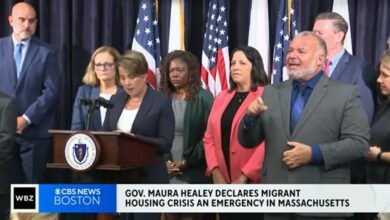
As soon as 12-year-old Aleisha Thompson wakes up, she gets her mom’s medication ready.
Then she gets ready for school. She makes sure her mom eats before walking to the school bus stop. In between classes, she texts her mom around midday to remind her to take her medicine and eat.
It’s important “she eats,” Thompson said. “She has to eat.”
Thompson’s 49-year-old mom Shelia Boatley is diabetic and disabled. Boatley has been disabled since 2000, with numerous health problems, including nerve and bone issues, poor vision due to her diabetes, and “severely elevated” white blood cell counts that doctors are still trying to figure out. Boatley’s deteriorating health over the past couple of decades prevents her from taking care of her children the way moms usually do.
Instead, roles are reversed in her household and quietly, in millions more across America, putting a financial and emotional strain on families and young children, health care experts say.
Lower your auto insurance costs: Find the best car insurance of 2023
“Caregiving youth are not on people’s radar,” even though there are growing numbers of them, said Connie Siskowski, founder of the nonprofit American Association of Caregiving Youth (AACY), which advocates for and supports young caregivers.
How many youth caregivers are there?
An estimated 5.4 million children under the age of 18 provided care to parents, grandparents or siblings with chronic medical conditions or functional decline in 2019, up from about 1.3 to 1.4 million in 2005, according to reports from the National Alliance for Caregiving and others.
But those numbers are a “gross underestimate,” Siskowski said. “I think it’s at least 7.5 million, conservatively.”
An aging population, more drug and alcohol use, mental health issues, shorter hospital stays and long COVID have likely boosted the need for kids to help in the home, experts said.

Additionally, “sometimes families don’t talk about it because they’re afraid if people knew, the child could be removed from the home,” she said.
Why are more youth taking on caregiving responsibilities?
In-home care and nursing homes are hard to find and unaffordable for most, especially if you’re still relatively young, experts said. At 49 years old, for example, Boatley could need care for another 30 years or more.
“Everyone lives so long but not necessarily healthier,” said Patrick Simasko, elder law attorney and financial adviser at Simasko Law in Mount Clemens, Michigan.
Most people also don’t want to live in a nursing home away from their family for that many years, he said.
At the same time, “no child in the United States should have to drop out of school or life to provide care for family members,” Siskowski said.
Is there government help for families and youths?
“There’s literally nothing out there in the way of government benefits to help” in the U.S., Simasko said.
President Joe Biden took executive action last year to expand care and raise wages, but none of them help youth caregivers.
Other countries like the UK and Australia recognize “young carers” through legislation and policy and offer stipends, Siskowski said. Unpaid youth caregiving labor is estimated at upwards of $8.5 billion, she said.
In the U.S., Medicare doesn’t pay family members to provide care and low-income families on Medicaid can only get reimbursement for adults.
If parents use their own money to pay the child and later get Medicaid benefits, the government penalizes parents for it by calling it a “gift,” Simasko said.
Medicaid usually has a five-year look-back period from the date you apply to prevent applicants from gifting assets to meet Medicaid’s asset limit. Money gifted for high school graduation, a vehicle donated to a local charity or payments to a personal care assistant without a formal contract are examples of what could be considered violations and disqualify you.
For adults only:Caregivers spend a whopping $7,200 out of pocket. New bill would provide tax relief.
Can nonprofits help?
Help is left to nonprofits in the U.S., experts said.
For example, AACY identifies young caregivers from 6th grade and helps build their caregiving skills, mental health and connections to others like them so “they know they aren’t alone,” Siskowski said.
AACY “has helped me with many things: mental health, tutoring, a computer and they have activities we may attend and sign up for,” Thompson said. “Sometimes we have camp and learn life skills or visit college campuses.”
She’s also met her best friends there. “I don’t have friends who go to my school, really,” she said. “A group tried jumping me, and I told the principal, so I stay in my own lane.” She said she prefers kids at AACY who are more like her and “a lot more open and polite. They show respect for others, aren’t rude and know how to communicate really well.”
AACY’s “work is to try to prevent that trauma, help kids today and tomorrow,” Siskowski said. “What people don’t realize, investment in this population can both help the workforce for the future and if the kids enjoy what they’re doing, they can go into healthcare as I did as a nurse.”
A study funded by The Bill and Melinda Gates Foundation found 22% of young adults who dropped out of school did so to care for a family member.
“If they drop out of school, society’s affected as well as you and your family,” Siskowski said, noting that they’ll more likely have low income, dependency problems or teen pregnancies.

What can families do?
Once in the situation, families have few options. “You can’t buy house insurance when your house is on fire,” Simasko said.
But if you’re still healthy and young, he said you can plan with:
- Long-term care insurance to help pay for assisted care, but you must buy it when you’re young and still healthy. Otherwise, it’s extremely expensive and premiums may rise.
- Hybrid life insurance, which pays for long-term care if you need it from your death benefit or a larger life insurance benefit if you don’t.




